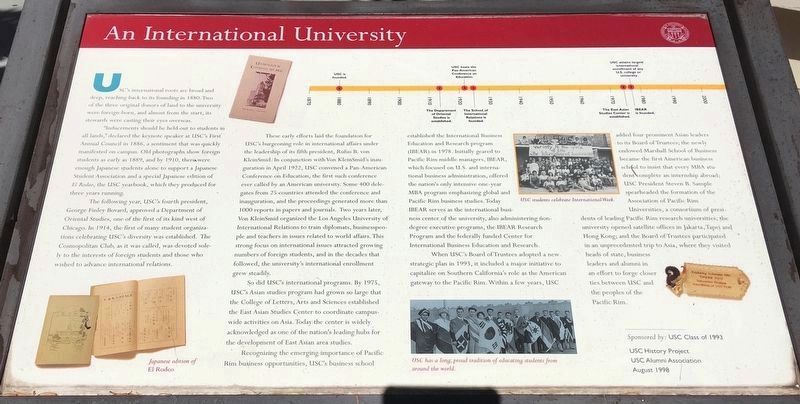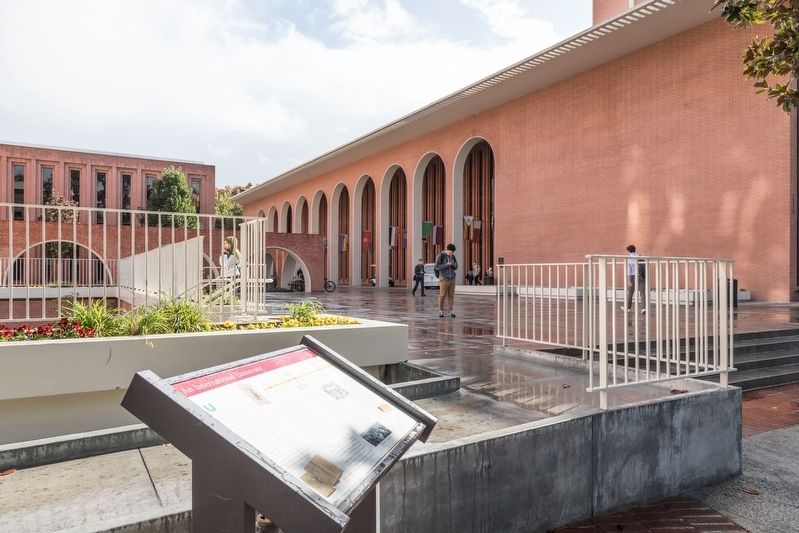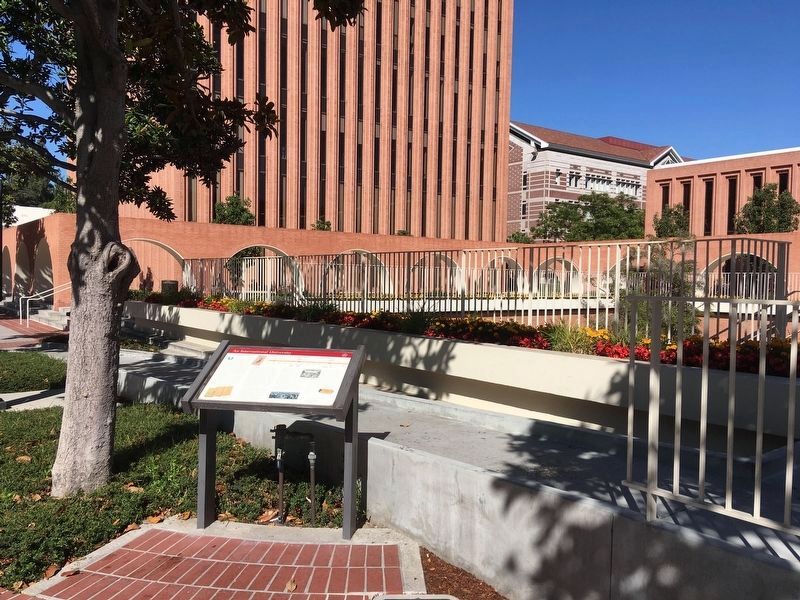South Los Angeles in Los Angeles County, California — The American West (Pacific Coastal)
An International University
ó USC ó University of Southern California ó
Inducements should be held out to students in all lands,” declared the keynote speaker at USCís First Annual Council in 1886, a sentiment that was quickly manifested on campus. Old photographs show foreign students as early as 1889, and by 1910, there were enough Japanese students alone to support a Japanese Student Association and a special Japanese edition of El Rodeo, the USC yearbook, which they produced for three years running.
The following year, USCís fourth president, George Finley Bovard, approved a Department of Oriental Studies, one of the first of its kind west of Chicago. In 1914, the first of many student organizations celebrating USCís diversity was established. The Cosmopolitan Club, as it was called, was devoted solely to the interests of foreign students those who wished to advance international relations.
These early efforts laid the foundation for USCís burgeoning role in international affairs under the leadership of its fifth president, Rufus B. von KleinSmid. In conjunction with Von KleinSmidís inauguration in April 1922, USC convened a Pan-American Conference On Education, the first such conference ever called by an American university. Some 400 delegates from 25 countries attended the conference and inauguration, and the proceedings generated more than 1000 reports in papers and journals. Two years later, Von KleinSmid organized the Los Angeles University of International Relations to train diplomats, business people and teachers in issues related to world affairs. This strong focus on international issues attracted growing numbers of foreign students, and in the decades that followed, the universityís international enrollment grew steadily.
So did USCís international programs. By 1975, USCís Asian studies program had grown so large that the College of Letters, Arts and Sciences established the East Asian Studies Center to coordinate campus-wide activities on Asia. Today the center is widely acknowledged as one of the nationís leading hubs for the development of East Asian area studies.
Recognizing the emerging importance of Pacific Rim business opportunities, USCís business school established the International Business Education and Research program (IBEAR) in 1978. Initially geared to Pacific Rim middle managers, IBEAR, which focused on U.S. and international business administration, offered the nationís only intensive one-year MBA program emphasizing global and Pacific Rim business
studies. Today IBEAR serves as the international business center of the university, also administering non-degree executive programs, the IBEAR Research Program and the federally funded Center for International Business Education and Research.
When USCís Board of Trustees adopted a new strategic plan in 1993, it included a major initiative to capitalize on Southern Californiaís role as the American gateway to the Pacific Rim. Within a few years, USC added four prominent Asian leaders to its Board of Trustees; the newly endowed Marshall School of Business became the first American business school to insist that every MBA student complete an internship abroad; USC President Steven B. Sample spearheaded the formation of the Association of Pacific Rim Universities, a consortium of presidents of leading Pacific Rim research universities; the university opened satellite offices in Jakarta, Taipei and Hong Kong; and the Board of Trustees participated in an unprecedented trip to Asia, where they visited heads of state, business leaders and alumni in an effort to forge closer ties between USC and the peoples of the Pacific Rim.
Erected 1998 by USC History Project, USC Alumni Association. Sponsored by USC Class of 1993.
Topics. This historical marker is listed in this topic list: Education. A significant historical month for this entry is April 1922.
Location. 34° 1.304′ N, 118° 17.054′ W. Marker is in Los Angeles, California, in Los Angeles County. It is in South Los Angeles. Marker is on Trousdale Parkway north of Hellman Way, on the right when traveling north. Touch for map. Marker is in this post office area: Los Angeles CA 90089, United States of America. Touch for directions.
Other nearby markers. At least 8 other markers are within walking distance of this marker. A Changing Campus (within shouting distance of this marker); The Founding of USC (within shouting distance of this marker); Dr. Joseph Medicine Crow (within shouting distance of this marker); The Trojan Column (within shouting distance of this marker); First Meeting of the USC Board of Trustees (about 300 feet away, measured in a direct line); Campus Life (about 300 feet away); Foundersí Fountain (about 300 feet away); Cesar Estrada Chavez (about 300 feet away). Touch for a list and map of all markers in Los Angeles.
More about this marker. This panel shows a timeline from 1870 to 2000 marking when USC was founded, the Department of Oriental Studies was established, USC hosted the Pan-American Conference on Education, and the School of International Relations was founded. It has a number of illustrations (clockwise from top left) beginning with an uncaptioned booklet titled “Universidad de California del Sur;” a photograph captioned, “USC students celebrate International Week;” a keepsake reading “Exploring Indonesia 1992, Thank You, Indonesian Student Association of USC 91/92;” a photograph of students wrapped in country flags captioned, “USC has a long, proud tradition of educating students from around the world;” and an image of the “Japanese edition of El Rodeo.”
Also see . . . Wikipedia entry for USC School of International Relations. Excerpt:
The founding occurred during the liberal-internationalist reaction to World War I. during this so-called Grotian moment, many in international relations desired to end war, and thought education was the best means to that end. According to the schoolís website, its founding mission was “to furnish opportunities for the training of statesmen for consular and diplomatic service, of businessmen for commerce and business administration, and of teachers in departments related to world affairs in colleges and universities.”(Submitted on February 21, 2019.)
Credits. This page was last revised on June 29, 2023. It was originally submitted on February 21, 2019, by J. J. Prats of Powell, Ohio. This page has been viewed 282 times since then and 29 times this year. Last updated on August 20, 2019, by Craig Baker of Sylmar, California. Photos: 1. submitted on August 20, 2019, by Craig Baker of Sylmar, California. 2. submitted on February 21, 2019, by J. J. Prats of Powell, Ohio. 3. submitted on August 20, 2019, by Craig Baker of Sylmar, California. • Andrew Ruppenstein was the editor who published this page.


